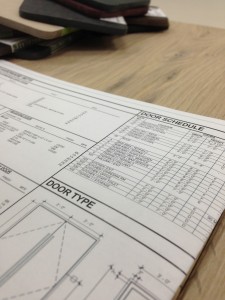 Do you ever see funny notes in completed construction drawings? I’ve seen notes on CDs out to bid that said things like “Match Lakeview storefront” (when Lakeview must have been an old project), and “Complete sill detail” (pointing to an incomplete sill detail). These notes simply make no sense to the people using the drawings (the contractor and subs). But you and I know that what happened is that a brand new architecture school grad was given sheets of drawings that were marked up in red, and she just incorporated the redlines verbatim as if they were drawing notes to add, instead of instructions to the person picking up redlines, and then her work never got checked before issuing.
Do you ever see funny notes in completed construction drawings? I’ve seen notes on CDs out to bid that said things like “Match Lakeview storefront” (when Lakeview must have been an old project), and “Complete sill detail” (pointing to an incomplete sill detail). These notes simply make no sense to the people using the drawings (the contractor and subs). But you and I know that what happened is that a brand new architecture school grad was given sheets of drawings that were marked up in red, and she just incorporated the redlines verbatim as if they were drawing notes to add, instead of instructions to the person picking up redlines, and then her work never got checked before issuing.
Specs – The Review Process
You and I know what happened with those redlines because we made the same mistakes when we were intern architects, and later, we saw the same sort of thing show up on redlines we prepared for someone else.
In my work as an independent specifications consultant, I prepare the architectural specification sections for the architect, based on the drawings and the architect’s design decisions. I ask some questions. I make some decisions based on my experience and technical knowledge. I give the specs to the architect for review.
I partially prepare the structural-related sections based on the drawings, and pass them on to the structural engineer for editing, completion, and review.
I receive the completed Mechanical/ Electrical/ Plumbing (MEP) engineering spec sections from the engineers and incorporate them into the project manual with the other sections.
Specs – The Hand Off
At the MEP firms, I sometimes deal primarily with administrative assistants. Sometimes the project engineers prepare the sections in Word and give them to the assistant to turn into PDFs and send on to me. Sometimes the assistant prints out the office masters on paper, the project engineers mark them up with red pen (or red pencil, for some reason), and the assistant does the word processing, turns them into PDFs, and emails them to me. And sometimes… I’m not sure exactly what happens over there.
This practice of handing off specs to an administrative person to process has been going on forever. Sometimes, in the olden days, the secretaries in an office were the only people who knew how to type, so this hand-off of specifications preparation was a very natural practice. Also, people used to actually cut (paper) and paste (with glue) to produce construction documents, including specs. It would be silly to have a project architect spend time doing this type of work for specs, so secretaries used to do this work. After many years of doing this, some assistants gain an incredible amount of technical knowledge.
There’s nothing wrong with this hand-off practice, when you have a careful engineer and a good assistant, or you have an extra-conscientious engineer and a decent assistant, or you have a decent engineer and a truly fantastic and experienced assistant. There’s nothing wrong with this practice when an experienced design professional is reviewing the work. Sometimes, I think, we have less-ideal situations, though.
Sometimes, the MEP specs have funny mistakes in them – things the engineer would know weren’t right, but an administrative assistant wouldn’t. Whoops – looks like the engineer didn’t do a final review after the assistant did the word processing. This is kind of like the situation with the intern architect and the redlines. When someone without technical knowledge (an emerging professional or an administrative assistant) is inputting markups, the person who created the markups ought to be reviewing the final document before it’s issued.
An administrative assistant may or may not have any idea what’s going on with the markups on the MEP specs. With specs, maybe even more than with drawings, if you mess up one word, you can totally change the meaning of the document.
As I heard an engineer say last week in a presentation, “If you’re only looking at the drawings, you’re only looking at half the project.” The contract for construction, a legal document, is made up of the owner-contractor agreement, the drawings, and the specifications. Who prepares your architectural specifications, which are half of the contract? How much time is spent on them? Are the right people working on them, or reviewing them? If you’re not giving input, and answering the specifier’s questions, are you at least reviewing the specs? Are experienced people with technical knowledge (and knowledge of the project) making the decisions and preparing or reviewing the final specification documents, or… not?
Minor incorrect items in drawings can be funny (“complete sill detail” pointing to an incomplete sill detail). But minor incorrect items in specs have the potential to cause major problems. There’s greater risk when your spec redlines get lost in translation. Review them, like you review your drawing redlines, or have them prepared by an experienced specifier who will know what all your markups mean.
A version of this post originally appeared on Liz O’Sullivan’s blog Comments from a Spec Writer.
